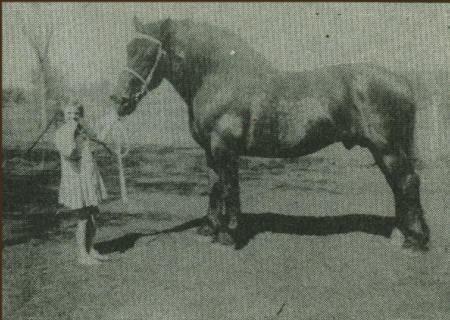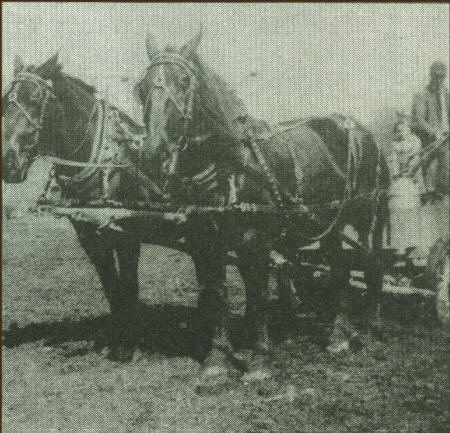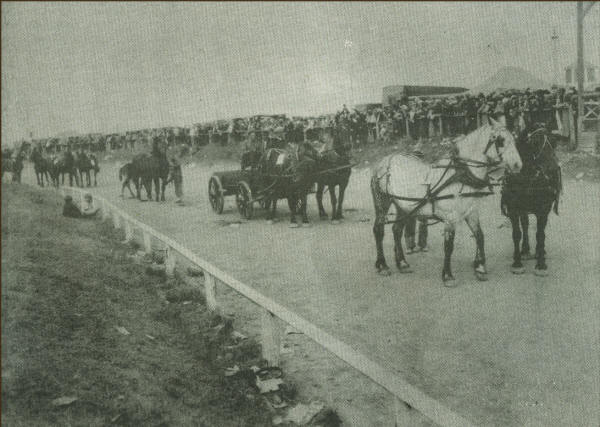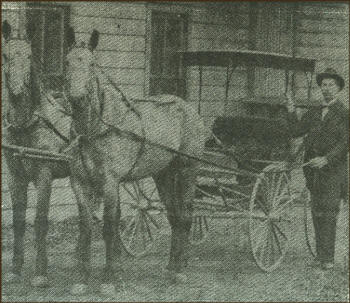|
|
|
Clark County Press, Neillsville, WI January 26, 1994, Page 28 Transcribed by Dolores (Mohr) Kenyon. Index of "Good Old Days" Articles
|
|
|
|
Clark County Press, Neillsville, WI January 26, 1994, Page 28 Transcribed by Dolores (Mohr) Kenyon. Index of "Good Old Days" Articles
|
Good Old Days
By Dee Zimmerman
HORSES
Animals of Necessity in Pioneering the American Frontier
The pioneers relied on their horses in helping them clear the land as they set up homesteads on the yet undeveloped land. In the beginning, oxen were used, but though strong, they were very slow. Horses became the means of power for hauling timber out of the woods, pulling stumps, drawing the plows-machinery and means to transportation, to and from town, by horseback or pulling the buggy.
Once a horse was “broken” or rather trained to accept a saddle and bridle, the next step was for his master to mount himself up in that saddle. Often, fear would strike that horse when that added weight hit the saddle – making for some excitement when the bucking started as the horse would try to throw off that weight. Horses reacted differently; some would put up little resistance, whereas others bucked, kicked and reared up endlessly. Getting horses used to a harness and pulling wagons or machinery, was also a challenge. Some men looked upon it as a sport, thoroughly enjoying the thrill of “breaking horses.”
Some men enrolled in a correspondence course entitled “How to Break and Train Horses,” by Prof. Jesse Berry. Wm. Joyce, Sr., of the Christie-Weston area was one who enrolled in such a course. He received a set of twelve booklets, an illustrated course on horse care and training. The end of the course required a written test for each participant in the course.
Those of us who grew up on farms during the “horse age” can remember the tough jobs that horses were called upon and directed to do for their owners, occasionally, such as during winter snowstorms, when trips had to be made through deep snow to get 6to town for supplies and food, taking little children to school because of the fear they might not be able to walk the long distance – times when the team of horses would lunge from one snow bank, into the next snow bank. Such duties had to have shortened their life span yet, they obeyed, doing as they were commanded.
Living on the Dakota prairie, as a youngster, I remember my dad was caught in an unpredicted snow storm “white-out” on his return from town, one day. He couldn’t even see the fence posts along the ditches, nothing to identify as landmarks – so he dropped the driving reins to the team of horses and let Molly and Maude find the way home. Horses like many animals, call upon their instincts in those situations, enabling them to sense the homeward direction. As dad was hoping, the team found the way not stopping until they reached the barn door, where they stood waiting for the door to be opened.
Many men, who owned horses, took pride in their steeds and gave them proper care, appreciating their loyalty. They would sometimes, challenge fellow horsemen as to who had the fastest team or whose team could pull the most weight.
In the early ‘30s, my dad and his white, matched team Molly and Maude worked at hauling gravel for the WPA project. After the second pay check (at 75 cents per hour), he bought a new set or (of) harness for the team, as the old harness would break, weak from years of wear. His reasoning, also, was that the horses were in (an) important part of the 75 cents an hour so deserved the reliable harness to pull with.
He bought red, white and blue rings, graduated in size, to place upon the driving rein strap leading from the bridle bit for about two and half feet, as a decoration, adding some color to the harness. In the evenings, he worked by kerosene lamp light, hand riveting the colored rings in proper order until the project was finished. The first day he drove off with the team decked out in their new colored rings and harness, I felt as proud as my dad in the way Molly and Maude appeared.
Clark County had horsemen to be remembered – those who bred and showed draft and middle-weight horses throughout the area.
One of those was Charlie Hubing, who grew up in a family of 10 children, living on a farm in the Pleasant Ridge area, east of Neillsville, along the road known today as Pray Avenue, south of Hwy. 10. He had six brothers and they all enjoyed their horses.
Hubing bought his first Percheron stallion, Big Master, in about 1929. He trucked the stallion around the central Wisconsin area, servicing mares for customers. On one occasion, as he was coming into Neillsville from the west on Hwy. 10, hauling the stallion in the open truck rack, a train came through just as he was under the trestle. The train noise scared the stallion so much he lunged and nearly upset the truck.
 |
“Big Master” the Percheron stud, was owned by Charles Hubing. Hubing’s daughter, Charlotte, held the lead rope as the picture was taken
Also, he bred, raised and sold colts from his own mares. During the winter of 1925, he hauled shale from the Neillsville shale pit. He would leave his farm and home at 3 a.m. to get to the pit by 5 a.m., as that was when the loading crew would start work. Some times, he would drop the lines, lay down in the sled and sleep while the horses walked to the shale pit. After all, they knew where they were supposed to go, and Hubing would wake up when he felt the sled stop.
The fellows had sort of a contest to see who would get to the pit first, as the first rig there was the first to be loaded and the rest had to wait in line. Waiting in line, during the bitter cold, was no fun.
The last load of shale that Hubing hauled out that winter made a record of being the largest load ever take out (of) the pit and area, to be hauled by horses. It contained eleven yards and six cubic feet. He had four horses hitched to the load which was hauled to the Town of York where crews were surfacing roads.
Every fall, Hubing took time to show his horses at the Black River Falls, Marshfield and Neillsville fairs. The stallion, mares and colts came home with many blue ribbons throughout the years.
After tractors came on the farm scene, the interest in horses declined, so Hubing sold the stallion and kept his work team until he retired in 1947.
 |
One of Hubing’s outstanding Registered Percheron teams, Jean and Bess, three and four year old, full sisters hitched to a wagon. Holding the driving reins is George Erickson and at his side is Charlotte Hubing (now Jacobs). Erickson started working for Hubing when he was thirteen years old. In 1937, he started breeding and raising registered Belgians. He sold his last horse a year ago.
 |
Horse judging at the Clark County Fairground, such as during Fair Week c.1920, was a yearly event. This photo was taken as the teams paraded around the race track. The second team was owned by Charles Hubing, who is viewed sitting in the wagon, accompanied by his brother Art. The third in line, a mare and her colt, were also owned by Erickson, being led by his brother, George. Notice the large number of people around the track and in front of the old grandstand. When Hubing traveled to the Marshfield Fair, George Erickson accompanied him, with several horses in tow. A team was hitched to a wagon, a couple colts ran along side, and some haltered steeds were tied to the back of the wagon. One man drove the team while the other man sat at the back of the wagon, caring for the other horses as they made their way down Hwy. 10.
Another renowned horseman was Ross Paulson of the Granton area.
At about the turn of the century, Paulson would often be seen whizzing over the roads, holding the lines to his perfectly matched buckskin team, making perhaps ten miles per hour. Watching him pass by would bring a smile to the faces of his neighbors.
In Paulson’s courting years, he would be headed toward Christie, going to the Delos Raymond house, where he would call upon a pretty maiden, Maude Raymond. Adorned in her Sunday best, she climbed up into Paulson’s canopy top buggy; seated next to him, they would travel behind the handsome buckskin team down the road to Neillsville at a fast clip. Miss Raymond became Paulson’s wife eventually.
 |
Ross Paulson, of the Granton-Neillsville area, shown with his well matched Buckskin team and the canopy topped buggy. At about the turn of the century, they turned many heads as they moved speedily along Pleasant Ridge.
Paulson operated a creamery at Granton and became addicted to horse. In 1905, he sold the creamery business, to concentrate on horses. For eighteen years, he worked at buying, selling and trading horses. During those years, he learned a great deal about horses through various experiences, wearing scars from being bit or kicked upon surprise attacks.
When Hwy. 10 was constructed west of Neillsville in the early ‘30s, Paulson had a contract on its construction, clearing and grading 9.9 miles of the roadway. It rained nearly every day, which made working conditions bad for the 60 horses he used on the job and for WPA workers, as well.
After the seven year stint of road construction, Paulson gave up to make way for the machine age. He returned to the selling and buying of horses until the demand of horseflesh waned and he quit that, too. So, for nearly fifty years, he had enjoyed his work with horses.
(Thanks to those who contributed photos and information for this article: Lila Hubing, Charlotte (Hubing) Jacobs, George Erickson)
To be continued…next week….Feb. 2, 1994
|
© Every submission is protected by the Digital Millennium Copyright Act of 1998.
Show your appreciation of this freely provided information by not copying it to any other site without our permission.
Become a Clark County History Buff
|
|
A site created and
maintained by the Clark County History Buffs
Webmasters: Leon Konieczny, Tanya Paschke, Janet & Stan Schwarze, James W. Sternitzky,
|